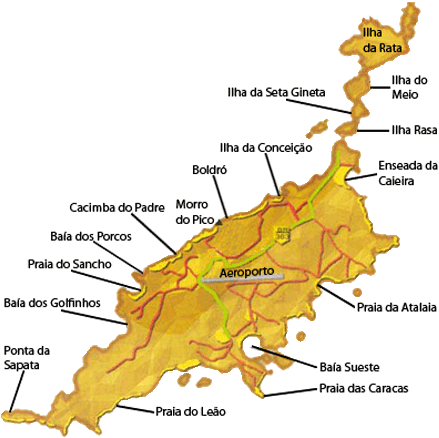Este post também está disponível em:
Português
English
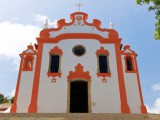
The Fernando de Noronha Archipelago consists of isolated volcanic islands in the South Equatorial Atlantic, its main island being the visible part of a chain of submerged mountains (DORSAL MEDIAN ATLANTIC).
Located at geographic coordinates 03 51′ south and 32 25′ west and approximately 345 km from Cape São Roque in the state of Rio Grande do Norte and 545 km from Recife, in Pernambuco.
The archipelago of Fernando de Noronha consists of 21 islands, islets and rocks of volcanic nature, the main island has an area of 18.4 km2 whose longest axis is about 10 km, maximum width of 3.5 km and perimeter of 60 km.
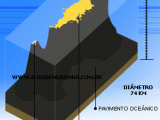
The base of this huge volcanic formation is more than 4,000 meters deep.
The main island of the Fernando de Noronha archipelago, named after the archipelago, constitutes 91% of the total area, with the islands of Rata, Sela Gineta, Cabeluda, São José and the islets of Leão and Viúva also standing out.
Studies show that the archipelago was formed between two and twelve million years ago.


Documentário sobre o arquipelago Fernando de Noronha

Geografia sobre o arquipelado Fernando de Noronha

História do arquipelado Fernando de Noronha

Turismo em Fernando de Noronha
Tourist Information about the Fernando de Noronha Archipelago
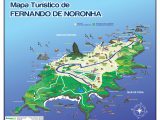
Schedule a trip to the archipelago of Fernando de Noronha, can mean the realization of a dream of most Brazilians.
In the Archipelago of Fernando de Noronha, you have the feeling of being in a part of Brazil that worked, there are 17 square kilometers at 545 km from the coast of Pernambuco, where a population of only 3,500 inhabitants lives and tourism is developed in a sustainable way, creating the opportunity for a balanced encounter between man and nature in one of the most important ecological sanctuaries in the world.
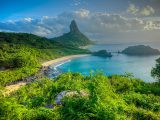
Coming to Noronha requires at least 5 days, to enjoy the numerous natural attractions and experience a little of the history of our colonization.
There are countless options of activities and tours, which cater to all audiences and offer the visitor the chance to see all the natural beauty of the islands.
The main activities in Fernando de Noronha are diving, snorkeling, diving, seeing dolphins, surfing and trails.
See the map of the beaches of Fernando de Noronha
View the map of the historical heritage
View the map of Fernando de Noronha Island.
Islands of the Fernando de Noronha Archipelago
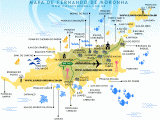
The others are contained in the area of the National Marine Park and are uninhabited and can only be visited with an official license from IBAMA.
1. Island of Fernando de Noronha
The main island has 17 km², with about 10 km long and 3.5 km wide. Its perimeter is approximately 60 km.
It is rugged, with several elevations, especially Morro do Pico, with 323 m high; Morro do Espinhaço, with 223 m; Morro do Francês, with 195 m; Alto da Bandeira, with 160 m; Morro do Curral, with 126 m; and Morro de Sto. Antônio, with 105 m.
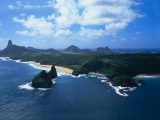
On this island are the historical sites (Vila dos Remédios, Vila da Quixaba, ruins of the Forts of São Pedro do Boldró, Sto. Antonio, N. Sª da Conceição and Parque de São Pedro do Boldró). Sª da Conceição and Parque de Sant’Ana), the residential villas of civilians, the village of the Department of Flight Protection of Aeronautics, the Airport, the Nursery, the School, the Hospital, the Tubarão Electric Plant, the Piraúna Water Treatment Plant, the Desalination Plant, the Garbage Treatment Plant and the Telephone services.
Part of this island has been a National Marine Park since 1988, with a spatial division identified as Environmental Protection Area – APA, with approximately 08 km², and PARNAMAR / FN Area, with 112.7 km², including the maritime part, as far as the sea is 50 m deep (isobath).
Around this larger island, other small islands, rocks and islets make up the scenery decanted by scholars and troubadours.
These are the SECONDARY ISLANDS, knowing today that all these islands were connected, forming a single block, separated over millions of years due to marine erosion. Click on the links below to learn about each of these islands.
Secondary Islands of the Fernando de Noronha Archipelago
2. Rata Island
The name is controversial. It would be the “Rapta” of the old books, the “Island of the Rats” mentioned by Friar André Thevet (in 1556).
It is the second in size, with 6.8 km², dark rocks and abrupt walls. It was inhabited by lighthouse keepers and their families at a time when its guiding beacon needed human maintenance.
The death of children due to the delay in the arrival of water on Rata Island, due to access difficulties, motivated the placement of the automatic lighthouse. It was also the base of the commercial experiment of the “Guano Company”, which exploited the “guano” (calcium phosphate) abundant throughout its surface, the result of the accumulation of solidified seabird droppings, considered “the largest deposit of zoogenic phosphates in Brazil”.
It includes the Pontal da Macaxeira and the Ilha do Lucena, which at high tide already looks like another island. Iron ladders embedded in the rock allow access for scholars and Navy control.
3. Middle Island
It is located between Rata Island and the Sela Gineta rock. It has a narrower base than its top and the waves breaking on its walls form cavities, much appreciated when it is coasted on sea trips.
4. Rasa Island
Located next to the Sela Gineta rock and next to the tip of Air France, on the main island, it is sandy, with a gentle top. It is the lowest in height of all the secondary islands, its top with eroded soil and full of pointed spaces. All indications are that this island was once associated with the body of the main island, in a period of lower sea than the present one.
5. São José Island
It is composed of dark basaltic rocks and is connected to the beach in the Air France region of the main island by a reef-like black pebble tombolo (one of the proofs of the union between the islands in the past), which allows access on foot at low tides.
The Fort of São Jose do Morro was built at the top in the 18th century, the only one of the defensive system then implemented in the archipelago, outside the main island, with the function of defending the Bay of Sto. Antônio, which is in front of it.
6. Cuscuz Island
A phonolitic rock located near the hill of São José, its name originates from the similarity of “cuscuz nordestino”, a food made from corn.
7. Lucena Island
Tip of Rata Island that has been separating, by the action of the sea. At low tide, you can still see the connection with this island.
8. Northeast Hat Island
Small formation next to the access rocks to Morro de São José.
9. Cabeluda Island
Similar to Sela Gineta Rock, it is also a phonolitic rock and is located at the exit of Sueste Bay, in the outgoing sea.
10. Ilha do Chapéu do Sueste
It resembles the Middle and Rasa Islands in its formation, and presents itself as a small mushroom. Its top is wider and the base near the height of the waves is narrower, forming a plateau just below, where aratus and crabs can be appreciated.
11. Ilha dos Ovos
Located in front of Enseada do Abreu, between Baía Sueste and Praia de Atalaia, it is also phonolitic.
12. Trinta-Réis Island
Small phonolitic high whitish due to the presence of guano in abundance, located near the “Chapéu do Sueste”, in the offshore sea.
13. Sela Gineta Rock
Composed of a phonolitic rock, it is located between the Rasa and Meio islands, standing out for its topographic grandeur. Its name derives from its resemblance to the saddle of a steed.
14. Dois Irmãos Rock
Two islands very similar to each other, formed by dark-colored volcanic rocks, on which there are deposits of “guano”, which adds a whitish air of rare beauty.
It is the most significant volcanic outcrop in the archipelago and inspired one of the famous legends of Fernando de Noronha: the LENDA DO PECADO, which considers it “the breasts of a gigantic woman, petrified by punishment for having sinned”.
15. Rock of Frade Island
An outcropping of phonolitic rock, in which fractures can be seen in its composition. It resembles a seated friar, wearing a hood, as if in a prayer position. It was once called “Island of the Bells” because of the sound of the sea hitting the rocks.
16. Rock near the Ilha dos Ovos, in the offshore sea
17. Rock located near Ponta das Caracas and Sueste Bay
18. Rock of Morro do Leão
A phonolitic rock similar to the Sela Gineta rock, it is located in the open sea, near Praia do Leão, resembling a sea lion, lying down, hence its name.
19. Rock of Morro da Viuvinha
It is also a phonolitic rock, located next to the Rock of the Lion, on the same beach, in the sea. It is a bird nesting site, i.e. an area where it is common for birds to make their nests.
20. Rocks of the Dry Stones
Three small phonolitic formations, located in the sea, far from the whole of the Fernando de Noronha archipelago, in the direction of Atalaia beach and Enseada da Caeira. Called “escolhos” by Américo Vespúcio in 1503, in his descriptive letter of the approach made to the shipwreck that occurred in this vicinity, it is the place where the official history of Fernando de Noronha begins.
History of the Fernando de Noronha Archipelago
In addition to the beaches, bays and rich nature, the archipelago of Fernando de Noronha also reserves other surprises for tourists.
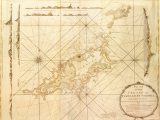
There are 500 years of history, which make the Archipelago, in addition to a Natural Heritage, a true Historical Heritage that deserves to be visited and, above all, preserved.
In this section, learn a little more about the history of the Fernando de Noronha archipelago, from its discovery until today.
Historical Periods of the Fernando de Noronha Archipelago
PERIODS OF ABANDONMENT, TEMPORARY OCCUPATION AND OF APPROACHES (1500/1736)
1500 – Appears on Cantino’s Map under the name “Lent”.
1503 – Discovered by Américo Vespúcio, member of the Exploratory Expedition, commanded by Gonçalo Coelho.
1504 – Donated, as a Hereditary Captaincy, to the Portuguese nobleman FERNAN (or FERNÃO) de LORONHA, financier of the Expedition of 1503.
1505 – The last castaways of the expedition of 1503 were rescued by a ship coming from Normandy (from Binot Paulmier de Goneville).
1534 – The German traveler Ulrich Schmidel disembarked and remained there for some years.
1556 – Approached by Frenchmen coming from Rio de Janeiro (Fr. André Thevet, companion of Villeigagnon).
1558 – Coasted by Frenchmen coming from Rio de Janeiro (Jean de Lèry, companion of Villeigagnon).
1577 – Approached by the English navigator Francis Drake, who was trying to sail around the world.
1612 – Approached for 15 days by the French who were going to Maranhão (Friar Claude d’Abeville, companion of Daniel de la Touche, Lord of la Ravardière).
1619 – Watched by a Portuguese expedition, which landed on the island and described it (Pedro de Castro).
1626 – Approached by Dutch who stop there to refresh themselves.
1629 / 1654 – Dutch possession, under the command of Corlizon Jol, the “Perna de Pau”.
1631 – Leased to Michel de Pavw (name: “Pavonia”).
1654 – Surrender of the island, after the Dutch surrender in Pernambuco.
1700 – Possession of the island was transferred to Pernambuco, which did nothing to occupy it.
1736 – Occupied by the French of the East India Company, who settled there for a year (name: “Isle Delphine” or “Dauphine”).
OCCUPATION AND DEVELOPMENT PERIOD (1737 / 2003) of Fernando de Noronha Archipelago
1737 – Resumption by Pernambuco, Construction of the Village and the Fortified System. Beginning of the Correctional Colony.
1739 – All the “gypsies” of Brazil, considered as “vagabonds”, are banished to Fernando de Noronha.
1745 – Passage of Juan and Ulloa (Spaniards).
1760 – Visit of a Swedish ship. Report of Ekeberg.
1816 – Passage of the French mission. Debret paints the Morro do Pico.
1817 – Rebellion in Pernambuco. Consequences for Fernando de Noronha: loss of what had been built and of the entire collection, removed by João de Barros Falcão de Lacerda.
1819 – Sending of Indians from the villages of Cimbres and Escada, to practice agriculture on the Island.
1824 – Only in this year it is known, in Fernando de Noronha, that Brazil was already independent from Portugal.
1823 / 1827 – Administered by the Ministry of War.
1832 – Passage of the scientist Charles Darwin. Description of the island.
1844 – The Farroupilha revolutionaries were banished to Noronha.
1877 / 1891 – Administered by the Ministry of Justice.
1890 – All the capoeiristas of Brazil, considered “troublemakers”, are banished to Fernando de Noronha.
1893 – The English of “South American Cables Ltda.” are installed.
1914 – The concession of submarine cables is transferred to the French (French Submarine Cable).
1925 – Italians from Italcable (Italian Submarine Cable) installed.
1927 – Cia. Generale Aeropostale (predecessor of Air France) is established.
1930 / 1931 – German and French airplanes operate in Fernando de Noronha, in the South Air Mail.
1934 – The first landing strip of Fernando de Noronha is built by the Civil Aeronautics Department.
1938 – The island is handed over to the Union for the installation of a political prison.
1942 – The Mixed Detachment is installed in Noronha, for war actions (World War II).
A base of the American Navy is installed near the Southeast Bay. The second landing strip is built.
The Federal Territory of Fernando de Noronha is created.
1942 / 1981 – Army
1981 / 1986 – Aeronautics
1986 / 1987 – EMFA
1987 / 1988 – MINTER
1946 – A FAB Detachment was created on the island for flight control and meteorological services.
1957 / 1965 – The Americans are installed in the Teleguided Missile Observation Post, near Boldró].
1988 – The Fernando de Noronha National Marine Park is created. Reintegrated to the State of Pernambuco, becoming a State District, commanded by an Administrator, appointed by the Governor of the State.
2001 – Listed by UNESCO as a “Natural World Heritage Site”, a title awarded in 2002.
2003 – Celebrations of the 500th anniversary of the “discovery” of the Fernando de Noronha Archipelago.
Historical Summary of Fernando de Noronha Archipelago
The occupation of Fernando de Noronha is almost as old as the mainland. Due to its geographical position, the archipelago was one of the first lands located in the New World, recorded in a nautical chart in 1500 by the Spanish cartographer Juan de La Cosa and in 1502 by the Portuguese Alberto Cantino, in this with the name “Quaresma”.
Its discovery, in 1503, is attributed to the navigator Amerigo Vespucci, who took part in the second exploratory expedition to the Brazilian coast, led by Gonçalo Coelho and financed by the Portuguese nobleman Fernão de Loronha, a New Christian who was a tenant of the Pau-Brasil extraction.
“Paradise is here.” This is how Américo Vespúcio described the island in 1503, which he called São Lourenço.
“Paradise is here,” said Vespucci when he approached that desert island on August l0, 1503, shortly after the wreck of the main ship of the six that made up the expedition.
The letter he wrote, LETTERA, is the first document concerning the island, which he called St. Lawrence, speaks of “infinite waters and infinite trees; very tame birds, which came to eat at hand; a very nice port that was good for the whole crew”.
As a result of the discovery, in 1504, it was donated to Fernão de Loronha, who had financed the expedition. It was the first Hereditary Captaincy of Brazil, but never occupied by its grantee.
Foreign invasions in the Fernando de Noronha Archipelago
Abandoned for more than two centuries and located on the route of the great navigations, it was approached by many peoples, being temporarily occupied in the 17th century by the Dutch (who called it “Pavonia”) and in the 18th century by the French (who renamed it “Ile Delphine”).
This point of vulnerability to invasions led to the definitive occupation by Portugal, through the Captaincy of Pernambuco, from 1737, and the defensive system was built with ten fortifications – “the largest fortified system of the 18th century in Brazil” – among which the Fortress of N.Sª dos Remédios. Most of these forts are still standing today and archaeological evidence remains of the others.
At the same time, the archipelago was transformed into a common prison for prisoners sentenced to long terms. These inmates were the labor force that built the entire built heritage and the road system that connects villages and forts.
The cruel regime even had solitary confinement and stone beds where the prisoner could barely turn on his side.
As a disciplinary measure to prevent escapes and hideouts for prisoners, the original vegetation has been cut down since that time, altering the climate of the archipelago. For this reason, only in a few places on the island can a little of the original vegetation cover be seen, such as at Ponta da Sapata, on the slope of Morro do Pico and at the viewpoints of Sancho, Baía dos Golfinhos and Praia do Leão.
Scientific Interest
Illustrious scientists have visited the archipelago at various times, such as the naturalist Charles Darwin, father of the Theory of Evolution of Species, in 1832.
All were attracted by its great biodiversity and collected data on the environment, describing it in memorable works. Also in the 19th century, artists such as the French Debret and Laissaily recorded human occupation on canvas.
Military Period in the Archipelago of Fernando de Noronha
In 1938, the Fernando de Noronha Archipelago was ceded to the Union for the installation of a Political Prison. In 1942, during World War II, the Federal Military Territory was created, together with the Mixed War Detachment and the alliance with the US Navy, which installed a Support Base on the island, with about 300 men.
During this period, an overpopulation of more than 3,000 expeditionaries led to the construction of pre-molded houses to house them. From 1942 to 1988, the island was administered by the military: Army until 1981, Air Force until 1986 and EMFA until 1987.
While it was still a federal territory, it passed to MINTER, with its only civilian governor. During this period, between 1957 and 1965, there was a new American presence at the Guided Missile Observation Post.
In 1988, by virtue of the Constituent Assembly, it was reintegrated into the State of Pernambuco, being today a State District. Also in 1988 the National Marine Park was created, coexisting, in the space of 26 km², the PARNAMAR/FN and the state Environmental Protection Area.
On December 13, 2001, UNESCO considered the archipelago a NATURAL WORLD HERITAGE SITE, and the diploma was awarded on December 27, 2002.
In 2003, 500 years of Fernando de Noronha’s entry into human history were celebrated. 500 years of its first approach, of its description, by one of the greatest navigators of history, Américo Vespúcio.
Archaeological, Architectural and Urban Heritage of the Archipelago of Fernando de Noronha
Other Urban Sets
Vila do Trinta
Built after the military occupation of 1942, around the Army barracks (the 30th Battalion of Hunters), its name comes from the “30” painted on the roof of the barracks. Around it was the “Sergeants’ Village”, dating from 1975.
The old barracks (the 30th BC) now houses the island’s supermarket and various other services. Next to it is the building of the old “Usina Eléctrica”, dating from 1942, and the houses that have been added. Currently, the building is called “Centro de Convivência”.
Next to the Village, a large building now serves as a fishmonger and bakery and was one of the island’s supply spaces, at the time of the military, called by them “Armazém Reembolso”. Opposite were houses that housed the officers.
Vila da Floresta Velha / School (1964)
Occupied from 1964 onwards, houses for army officers and the building of the Arquipélago School (formerly called the “Integrated Teaching Unit”) were built there.
Behind this urban center is the island’s cemetery, which dates from 1843 and was enlarged in 1883. There used to be a chapel in honor of Our Lady of the Conception, now destroyed. Next to it are houses built on the bases of war groups.
In front of this complex, the Vila para Cabos was built, with pre-molded houses and, later, one of the evangelical churches of the island was installed there.
Vila da Floresta Nova (from 1987)
It is a village of wooden houses, typical of Paraná, built from 1987, during the management of the Ministry of the Interior and the first Civil Governor of the Island. In this area, at the top of the hill, is located the Golfinho Radio and TV System, in pre-molded construction.
Parque dos Flamboyant (Bosque)
A square for socializing, wooded and with leisure equipment, it was defined in the military period and gained extensions and landscaping at different times. In its vicinity was the building that housed the second school on the island, demolished during the Air Force government.
Pre-molded Houses of São Miguel Street
Sequence of pre-molded houses, from the Corporals Village of the military period, in the old Rua do Sol, today Rua São Miguel. In front of this village, some differentiated houses exist, including the one that served as a Mothers’ Club. There are also Soldiers’ Villages (“Vila Fruta-Pão”).
On the left side of Rua São Miguel (former Rua do Sol), there are still marks of the old houses that were demolished for the widening of the street, during the Army period.
Vila dos Três Paus
A small urban center located off the main road, it is a circular settlement that emerged in this century, probably to house convicts and their families. During the military occupation, a leisure center operated there: the “Boite Três Paus”.
Porto
Used as a port since the discovery, the cove of Sto. Antonio has always been a place of loading and unloading of vessels arriving or leaving the archipelago. A wooden and iron pier was built during World War II to allow ships to dock and cannons to be unloaded.
In 1987, a permanent pier was built using stones obtained by blasting Boa Vista Hill, but it is not yet fully completed. Several tourist facilities support this site, where fishing and diving boats are placed.
Air France
Site where the French settled in 1927 to support air navigation. It had three buildings for the technicians to live in and to store their work equipment. Today, restored, the house that remains has become the “Air France Cultural Space”, housing the Association of Artists and Artisans Noronhenses.
Alameda do Boldró
Area where the Americans settled in 1957, at the Guided Missile Observation Post. In this Alameda are the Tubarão Thermoelectric Plant, the Piraúna Plant, the Esmeralda Hotel, the TAMAR Project headquarters, the IBAMA headquarters and several houses of different residents.
Further on, facing the sea, is the Mirante do Boldró Bar. In the lower part, next to the sea, another bar serves those who frequent this beach.
Basinha
Next to the Fort of São Pedro do Boldró is the Hotel that houses the technicians of the administration of the archipelago, when on duty on the island. They are wooden houses, similar to those used in the New Forest and has capacity to host 16 people.
In front of the hotel, other houses of the same material house technicians on duty who need to reside on the island, such as doctors, teachers, electricity and water treatment personnel, among others.
Vila da Quixaba
One of the primitive urban centers of the island, it was built around the Chapel of Our Lady of the Conception and the “Sentenced Lodging”, a beautiful house that was destroyed by an explosion at the time of World War II. Apart from the chapel and the large building, 28 houses served as residences for open regime prisoners.
The chapel of Our Lady of the Conception had three successive phases of construction. Built by convicts, it collapsed, was rebuilt and collapsed again on a stormy night.
The current face of the chapel dates from the second half of the 18th century, its third construction. It is a building of small proportions, in stone, with a central door and altar in mass, with curious details that, analyzed at the end of 1999, encouraged its complete restoration.
The entire building and its surroundings were also restored. The intervention saved the memory of the old Vila da Quixaba and encouraged the beginning of an action, in the line of Heritage Education, of archaeological research in the surroundings of the same, to identify the old priest’s rest house and the old “Prison Lodging”, once existing.
The work, carried out in 1999, led to the placement of a ceramic information panel, illustrated with photos, presenting a complete retrospective of the Vila da Quixaba space and the restoration stages.
Isolated Built Heritage
Big house of Sueste
On the old road of Sueste is this building, which is probably the oldest house built on the island.
It served as the summer residence of the commanders of the prison and housed, at two times, the beriberi hospital, due to the climate in its surroundings and the large amount of citrus fruits in the vicinity. Nearby is the Pedreira Dam, which resulted from the blasting of Boa Vista Hill to obtain stones for the construction of the pier at the port.
Frigorífico Velho
On the way to Praia de Atalaia is this large building, from the time of the American presence in World War II. Today unused, it is a building of great proportions, possible to be included in the process of requalification of buildings.
Air Force Transit Hotel
A large building, located on the hill of Sto. Antônio, had three different periods of construction and different uses.
There was the Navy Weather Station, still standing in 1934, when it was portrayed by Percy Lau.
Under its ruins stood the house of the military governor of the Army in the 60s. Later, it was demolished to make way for the current building, also a government residence until the reintegration of the Archipelago to Pernambuco, when the area was donated to the Ministry of Aeronautics, serving as a Transit Hotel for authorities visiting Fernando de Noronha.
Chapel of São Pedro dos Pescadores
Small chapel located in the upper part of the Air France region, it has no regular worship, only being used on the occasion of the Feast of St. Peter, when the “Buscada Marítima” in praise of the patron saint of fishermen departs from there. The area is an excellent viewpoint.
Built Heritage of Vila dos Remédios
Igreja de Nª Sª dos Remédios
The Church of Our Lady of Remedies is the main Catholic temple in the archipelago of Fernando de Noronha, had its construction started in 1737 and completed all the work of structure in 1772, date that bears on its facade, being added to it the ornaments and movable cultural goods from then on, ending in 1784.
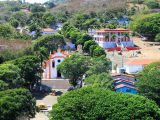
And the Virgin of Remedies was taken as the patron saint of the common prison from 1768. In 1789 this church was ecclesiastically attached to the Parish of Saint Friar Pedro Gonçalves, as an extension of it. This dependency exists to this day.
Its first major restoration took place in 1891, followed by further interventions in 1915 and 1919. The last and reliable restoration took place in 1988, with federal resources, and had its inauguration presided by the Archbishop Emeritus of Olinda and Recife, Dom Hélder Câmara.
In 1997, the temple was revitalized by painting and night lighting, standing out in the landscape at night.
In 1981, this church was listed by the National Historical and Artistic Heritage Institute, being the second monument to receive this distinction in the archipelago. In 1998, the revitalization of the church by painting took place, when the temple returned to its original colors.
São Miguel Palace
Headquarters of the administration of the State District of Fernando de Noronha, it was built in 1947/48 on the ruins of the old “Directoria do Presídio”.
This was a colonial mansion located in the center of the square of arms of Vila dos Remédios, with ogival windows, a single floor and a large access staircase.
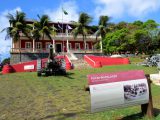
The palace was built by people from the island itself, under the coordination of former communist political prisoner Mariano Lucena.
Its construction and architectural alteration was intended to house the seat of government of the Federal Military Territory. In some periods of government, the lower floor also served as the Governor’s residence.
Some of the walls of the building have left evidence of the previous stone construction, the result of the prison labor force that existed at the time.
Inaugurated in 1948, it has mid-century furniture and two large, ornamental canvases by the Pernambuco painter Wash Rodrigues, who was brought to Noronha precisely to do this work.
There is also a stained-glass window, with the image of the archangel St. Michael, in natural size, made by the stained glass artist Aurora Lima, a disciple of the German artist Henri Moser, restored in the year 2000 by followers of the Moser school.
Old Warehouse of Agricultural Products
Agricultural Warehouse
A building with the largest volume of civil architecture in Noronha, as evidenced by the iconography of many periods, in which the building appears with many uses. Today it is an object of interest as a landmark in the recovery of the island’s scenography.
Among various functions, it served as the residence of the prison director, a warehouse for agricultural products, a storehouse, a bakery, a carpenter’s shop, a barracks for soldiers during World War II and, again, as a residence for islanders. Finally, abandoned, it began to deteriorate, and it is known with certainty that it was still standing and covered in 1972.
The damage to the building is already quite significant and needs to be combated, lest there be a total loss of this excellent example of the island’s civil architecture. The main proposal for the requalification is to transform it into a contemporary cultural space, due to its excellent location and architectural proportions.
In 2003, it was registered in the National Register of Archaeological Sites – CNSA -, of the National Historical and Artistic Heritage Institute.
Old Cereal Warehouse
Cereal Warehouse – a large building, located at the end of the square in front of the Remedios Church, used to store cereals and later as a “prison garage”.
Abandoned, it was being destroyed and, in 1990, part of it was restored to house the Tourist Terminal of Cachorro beach, as support for the cruise ships that started that year and today houses the famous “Bar do Cachorro”.
Antiga Aldeia de Sentenciados
The only remaining building of the prison system that operated in Fernando de Noronha for more than 200 years, the “Aldeia dos Sentenciados” is a remarkable, large building with well-defined internal spaces, designed to house single prisoners.
Located in Vila dos Remédios, in the old Praça d’Armas, next to the São Miguel Palace, it was – in the last century and from the permission to send women prisoners to the archipelago – also called “Women’s Prison”, for housing sentenced women.
Inside, there were collective cells, spaces for confined prisoners, a bakery, cafeteria, kitchen, administrative areas and internal “open-air” courtyards.
In front of this building, prisoners of good behavior, who lived with their families, were obliged to go to morning roll call each day. Next to it are the ruins of the Atlantic Club, built on what was left of the old French Cape cottage. During World War II, the building housed soldiers. Then, abandoned, it was used as a makeshift residence, a situation it still maintains today.
Elizabeth Garden
Used as a place for acclimatizing plants since the 17th century, it was also the “Horta da Vila”, designed to supply Vila dos Remédios with agricultural products. It also has bridges, terraces suitable for agriculture, stone roads, as well as abundant vegetation.
It is also a functional landmark of Noronha, as a repair port for ships, using the abundant material in these areas of permanent reforestation.
Rediscovered in 1997, during the survey of the elements that would guide the implementation of the “Ecotourism Trails Project”, it is a pleasant place, which today has a constant tourist flow.
Secular Routes
Original nucleus, built in the 18th century, Vila dos Remédios required the construction of accesses throughout the island, connecting it to the other occupied points and generating a road system made of stone, with prison labor.
The Estrada do Pico, Estrada da Porto, Rua da Estrela and Estrada da Ponte stand out. All these roads appear on the plan by José Fernandes Portugal, made in 1798.
These access roads have been degraded with use and, above all, with the introduction of the vehicle for locomotion on the island. Large stretches without stone have problems with decomposition of the sidewalk, threatened in their use by the fragility of the whole system.
Bica da praia do Cachorro
A secular spout, which serves for freshwater bathing of those who use Praia do Cachorro as leisure. It is located next to the Redoubt of Sant’Anna, built in the 18th century.
It is partially ruined, with the dog’s face that gave it its name, which was made of bronze in a beautiful artistic work, no longer existing. There are records of this area since the beginning of the last century, and the spout is still used today.
Old School
The first teaching experiences in Noronha were improvised. The sacristy of the church was used as a support point for the school. At the end of the last century, some simple buildings, built to be residences, were improvised as schools for boys and girls.
In this century, in Praça d’Armas, opposite the “Directoria do Presídio”, a building was constructed as a school, with two classrooms (girls’ and boys’) and a school board.
A solarium completed the beautiful building, with the coat of arms of the Republic at the top. During the Second World War, this house was used as the headquarters of Radio PTI, adding to the solarium the spaces that served this purpose and an antenna at the rear.
To access the solarium, a staircase was also placed at the rear of the building.
Abandoned, the building was almost completely ruined, but was saved by Banco Real, which had already been on the island since 1975 (in a room in the São Miguel Palace), which adapted it to house a bank branch. Since it was impossible to restore the solarium, a canal tile roof was installed, similar to the one used on the neighboring church. Inside the branch, a retrospective panel shows iconographically the faces of this building through the ages.
Vila dos Remédios
Although discovered in 1503 and donated as a Hereditary Captaincy in 1504, the Archipelago of Fernando de Noronha remained abandoned for more than two centuries, receiving passing approaches from navigators of various nationalities.
In the 17th century the Dutch remained there for 25 years. Almost nothing remains of that time, apart from a part of the walls of the present-day Fortaleza dos Remédios (where they built a stronghold in 1629) and the spaces of the agricultural experiments.
The accounts of that time speak of “warehouses”, “dwelling houses”, “goods warehouses”, “corrals”, “vegetable gardens”, a small “Calvinist Reformed Congregation”, among other constructive evidence for such a long occupation.
In addition to the “Elizabeth Gardens”, where crops were experimented with, especially indigo. And the space of this Dutch “Village” was precisely where the VILA DOS REMÉDIOS was made, in the following century, after the definitive occupation by Portugal, through the Captaincy of Pernambuco.
Vila dos Remédios was the place chosen by both the Dutch and the Portuguese-Brazilians as the main urban center in the Fernando de Noronha archipelago.
The strategic conditions of this location were evident: close to a water stream called Riacho Mulungu and other springs; easy access to Enseada do Cachorro, which eventually served as an anchorage; the source of drinking water later transformed into Bica do Cachorro; direct access to the new fortress (Remédios).
Everything led one to believe that this was the ideal place to establish the main town.
Urban Development of Vila dos Remédios
Nossa Senhora dos Remédios Fortress
The urban layout of Vila dos Remédios in the Fernando de Noronha archipelago, with its planned structure, consisted of two courtyards (two spatial units). In the upper space was the Administration, the civil power, and in the lower, the church, the religious power.
The entire area was paved in stone and the buildings constructed were always large. It is worth noting that one of the main functions of the village, in its origin, was to support the prison system also implemented at that time. Strategically the village should not be seen from the sea.
VILA DOS REMÉDIOS in the archipelago of Fernando de Noronha emerged as the main urban center of the island.
From the 18th century onwards, it was home to the administration, with its public buildings, prison accommodation and workshops for inmates, the church, the command square or square of arms, the dwelling houses, the warehouse, the school, the hospital and the warehouses for storing agricultural production and goods from the mainland.
It also gave rise to the road system paved throughout the island, using the “cabeça de nego” model, with concern for rainwater drainage and soil conservation, a procedure adopted in the courtyards and streets that define the village.
For more than two hundred years this nucleus has been used and preserved in its original structure, with minor modifications and additions. In 1938, when the archipelago was handed over to the Federal Government, the village was architecturally extremely well cared for.
The major interferences and disfigurements were felt, for the most part, from 1942 onwards, with the occupation during World War II.
Part of the old urban face was then lost, and the influence of prefabricated construction emerged, due to its practicality in times of emergency, becoming a reference in this technology.
History, Geography and Tourism of the Fernando de Noronha Archipelago
